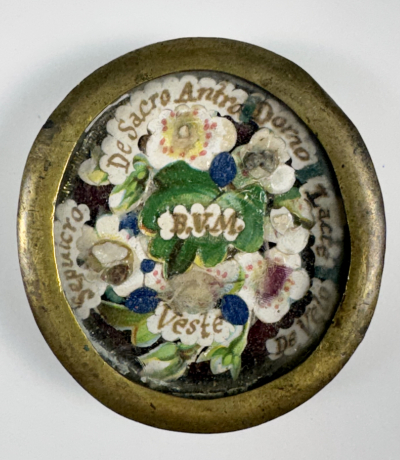According to tradition, the Veil of the Blessed Virgin Mary was worn by the Virgin as she stood at the foot of the Cross. It had been transferred in the early years of Christianity from Jerusalem to Constantinople when it was presented by the Byzantine Empress Irene to the Holy Roman Emperor Charlemagne. In 876 his descendant Charles the Bald gave the relic to the cathedral at Chartres. The Veil is kept in a golden reliquary beside the high altar and has formed the focus of many traditions throughout the centuries. It was believed to have protected the faithful down through the centuries from many dangers and evils, including famine and war, outbreaks of the plague, and the worst ravishes of the French Revolution. The veil itself is more than six meters long and made of silk. Scientific studies have shown that it is of Syrian design, of fine quality, and can be traced to the first century. Every year on 15th August, the Feast of the Assumption of Our Lady, the Veil is processed through the town of Chartres.
The House of the Virgin Mary is a Catholic shrine located on Mt. Koressos in Turkey. The house was discovered in the 19th century by following the descriptions in the reported visions of Blessed Anne Catherine Emmerich (†1824), a Roman Catholic nun and visionary, which were published as a book after her death. The Catholic Church has never pronounced in favour or against the authenticity of the house, but nevertheless maintains a steady flow of pilgrimage since its discovery. Catholic pilgrims visit the house based on the belief that the Virgin Mary, the mother of Jesus, was taken to this stone house by Saint John and lived there until her Assumption (according to Catholic doctrine) or Dormition (according to Orthodox belief). The shrine has merited several papal Apostolic Blessings and visits from several popes, the earliest pilgrimage coming from Pope Leo XIII in 1896, and the most recent in 2006 by Pope Benedict XVI.
The Sepulcher of the Blessed Virgin Mary is now housed inside the Church of the Sepulcher of Saint Mary at the foot of Mount of Olives, near Jerusalem. The stone bench on which the Virgin's body was laid out, now encased in glass. The Armenian Patriarchate Armenian Apostolic Church of Jerusalem and Greek Orthodox Church of Jerusalem are in joint possession of the shrine.
The Grotto of the Nativity is located inside of the Church of the Nativity, a basilica located in Bethlehem. Over the centuries, the surrounding compound has been expanded, and today it comprises three different monasteries: one Catholic, one Armenian Apostolic, and one Greek Orthodox. The grotto holds a prominent religious significance to Christians as the birthplace of Jesus and is the oldest site continuously used as a place of worship in Christianity. The Grotto of the Nativity is an underground space which forms the crypt of the Church of the Nativity. It is situated underneath its main altar, and it is normally accessed by two staircases on either side of the chancel. The grotto is part of a network of caves. Catholics are in charge of a section of the grotto known as the "Grotto of the Manger", marking the traditional site where Mary laid the newborn baby in the manger.
Christians venerated the Holy Milk of the Blessed Virgin Mary from the first century on. They held as sacred a white powder that was scraped from the walls of the shelter in Bethlehem where Jesus was born. Later that white powder from the stable of the Nativity was thought to be Mary’s dried milk. Three “drops of this milk” eventually made it into a medallion that emperor Charlemagne (†814) used to carry into battle. The Vatican claims that the breast milk of Mary was first contained in “Milk Grotto in Bethlehem”. The milk made the rock white, and the powder from the rock was collected and venerated as it was believed to have healing powers.









 Поменять язык на русский
Поменять язык на русский 